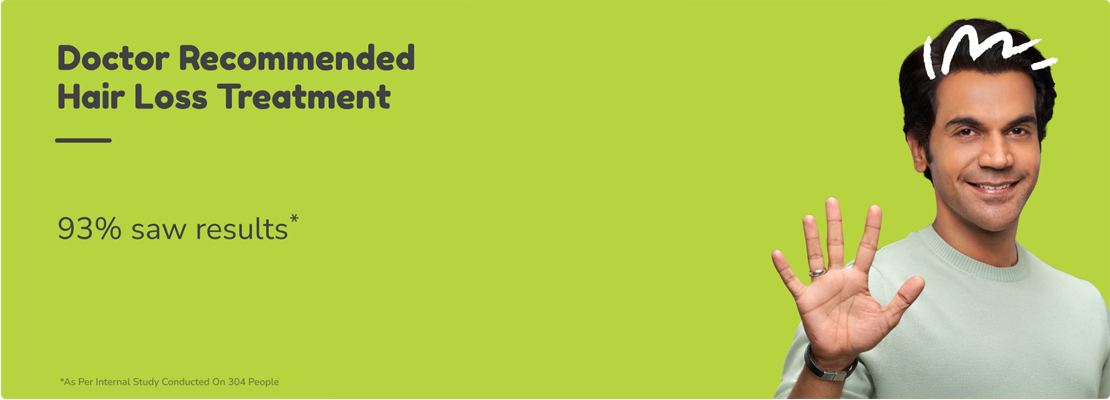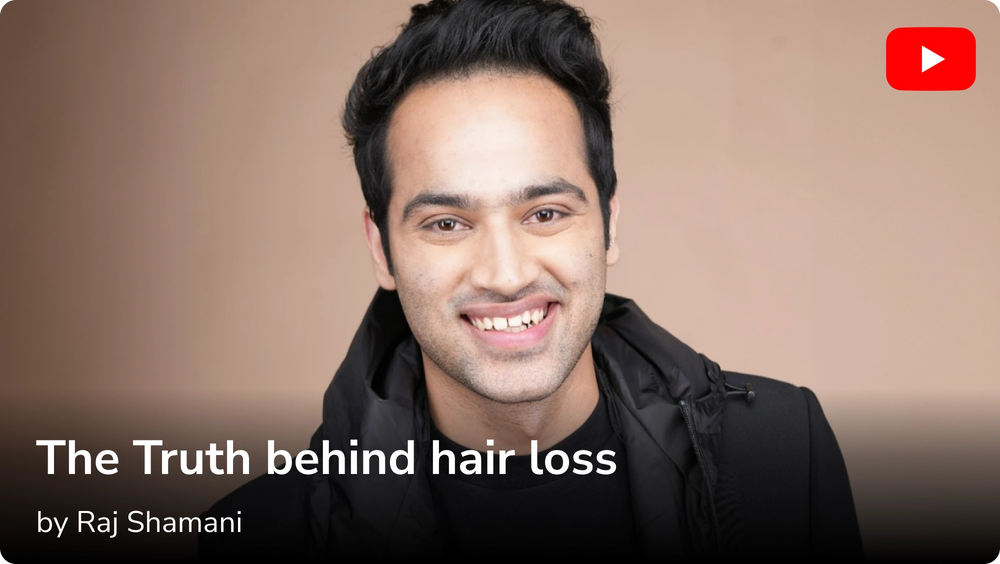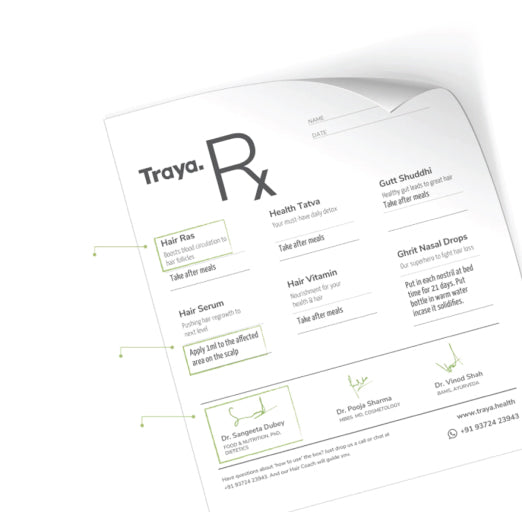In a monumental effort, Traya analyzed information collected from a whopping 5,36,622 participants. This extensive data collection involved men across India who took a hair test. The primary goal was to gain unprecedented insights into hair health among young Indian men.
Hair loss is a common concern in India, especially among men. However, it's often viewed as a cosmetic rather than a potential indicator of underlying health issues. Recognizing the need for a comprehensive approach, Traya embarked on an ambitious nationwide study involving data collected through hair tests taken by over 5 lakh men. This initiative aimed to uncover the root causes of early hair loss and, importantly, to raise awareness about its onset. Now, let's explore the significant findings from this massive study.
Methodology:
Traya's Hair test, developed with medical experts and powerful AI technology, is a comprehensive diagnostic tool for identifying the underlying causes of hair fall. Traya's "health first, hair later" approach prioritizes providing accurate and factual information about hair loss. It ensures that many people take Traya's hair test to discover the reasons behind their hair loss and adopt a holistic approach to address the cause. This data was collected from the hair tests taken by over 5 lakh men across the country over a period of three months.
Hair test Questions:
Our hair test asks participants questions about their hair and overall health. These questions cover aspects such as hair quality, dandruff conditions, hair goals, family medical history, visual representations of their hair, any detected illnesses, fluctuations in weight, recent surgeries, heavy medication, daily energy levels, gut health, stress levels, sleep patterns, thyroid imbalances, blood pressure, and scalp conditions. We also ask for a picture to help diagnose the problem.
These comprehensive questions ensure that the treatment provided by Traya is personalised and tailored to each individual's specific condition. Traya aims to directly address the root causes of hair issues and provide effective solutions accordingly.

Scale: Traya uses the Norwood Hair Loss Scale to identify the stage of hair loss in Men.
Findings:
Our study focused on Indian men, and the results have unveiled some striking insights into their hair health.
Increased Stress Levels:
Starting with the most startling discovery, 60% of these young men under 25 are experiencing hair loss due to increased stress levels. This emphasises the critical importance of stress management, particularly in this age group, to maintain healthy hair.
Sleep-Related Issues:
Sleep-related issues are also taking a toll, with approximately 30% of individuals under the age of 25 are experiencing hair loss due to irregular sleep patterns. This highlights the vital role of maintaining healthy sleep habits, especially for those in their early twenties.
Weight and Dieting:
Moving on, we found that 13% of young men under 25 are dealing with receding hairlines, while an equally concerning 13% are facing hair loss due to changes in weight, such as extreme dieting or significant weight gain or loss. These statistics underscore the significance of maintaining a balanced diet and healthy weight in this age group for good hair health.
Hair loss due to Dandruff:
Dandruff is another pressing issue, affecting a significant 65% of young Indian males under 25, with 38% experiencing severe cases. Addressing dandruff becomes paramount to prevent hair loss in this age bracket.
Poor Gut Health
Additionally, our study revealed that 37% (1,98,550 people) of all participants in this study attributed their hair loss to poor gut health. This suggests a strong connection between digestive well-being and hair condition, making holistic health crucial for young men's hair health.
Growing Awareness at an Young Age
Intriguingly, we found a growing awareness among these young individuals regarding hair fall, even at an early stage. This heightened consciousness is promising and encourages timely intervention and treatment.
Lack of Early Action
However, it's concerning that a significant proportion of respondents aged 21-25 progress to Stage 2 of the Norwood Hair Loss Scale due to a lack of treatment during Stage 1. This highlights the critical need for early intervention and taking action to improve hair fall when caught.
Genetics
Finally, genetics also plays a role, with over 60% of men under 25 believing it significantly contributes to their hair loss. Understanding hereditary factors is crucial for these young individuals navigating their hair health journey.
In summary, the findings of our study illuminate the hair health challenges faced by young Indian men under 25. These results underscore the importance of stress management, healthy sleep habits, a balanced diet, and addressing dandruff for maintaining hair health in this age group. Additionally, the need for holistic well-being, early awareness, and understanding of genetics in the context of hair loss cannot be overstated.
Key Takeaways

Takeaway

One of the most promising takeaways from our study is the growing consciousness of hair fall among individuals at an earlier stage. This heightened awareness is a positive development, as early detection of hair fall significantly increases the chances of recovery. However, a concerning trend also surfaced - despite increased awareness, many individuals are not taking timely action.
Our study revealed a significant misconception, with over 60% of men under 25 believing that their hair loss is primarily due to genetics. While genetics can play a role, it's essential to understand that various factors can contribute to hair loss in men. This highlights the need for comprehensive education on the multiple causes of hair loss.
Traya has consistently advocated that a single product cannot solve hair loss because it is not a cosmetic issue. Hair loss requires a multifaceted solution that targets the root causes. Recognising that hair loss is a complex problem with no one-size-fits-all solution is crucial. Our findings emphasise that a personalised and holistic approach is necessary to address hair loss effectively. Our holistic three-science formula addresses these issues comprehensively and has delivered results for 93% of our customers.
Limitations
The study predominantly focused on men who gave the hair test. This could introduce a sampling bias. Moreover, as the study relied on participants self-reporting their hair-related issues and lifestyle factors, data can be subject to inaccuracies, as individuals may not always provide completely truthful or comprehensive information. The study focused primarily on stress, sleep, diet, and other factors related to hair health. It did not delve into medical conditions or medications that may also impact hair loss. This limited scope might miss potential underlying causes of hair issues.
Conclusion

Traya's study marks a significant leap in our understanding of early hair loss among Indian men. These findings offer invaluable insights into the diverse factors contributing to hair fall, enabling individuals to take proactive steps towards nurturing their hair. While early awareness of hair fall is rising, the study also highlights the urgent need for timely action and accurate information dissemination. Genetics alone do not determine one's hair fate, and understanding the multifaceted nature of hair health is paramount.
This study serves as a clarion call, urging individuals to care for their hair and overall well-being proactively. As we move forward, a collective effort from individuals, healthcare professionals, and society is essential to combat hair fall effectively. Furthermore, the study underscores the importance of adopting a holistic approach to hair health, drawing upon the wisdom of Ayurveda, Nutrition, and Dermatology. The study findings offer profound insights into the intricate facets of hair fall, equipping individuals with the knowledge needed to nurture their hair's health proactively.
Traya’s free online hair test has been co-created with medical professionals and can help diagnose the root cause of hair fall with its powerful AI technology. Traya Health creates personalised hair treatment plans to help manage hair loss.






































